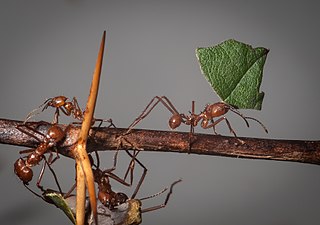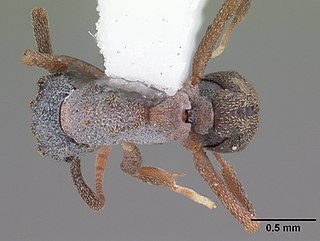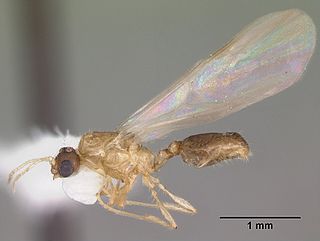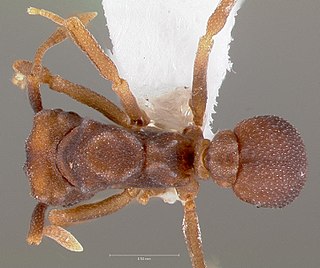
Ants are eusocial insects of the family Formicidae and, along with the related wasps and bees, belong to the order Hymenoptera. Ants evolved from vespoid wasp ancestors in the Cretaceous period. More than 13,800 of an estimated total of 22,000 species have been classified. They are easily identified by their geniculate (elbowed) antennae and the distinctive node-like structure that forms their slender waists.

Leafcutter ants are fungus-growing ants that share the behaviour of cutting leaves which they carry back to their nests to farm fungus. Next to humans, leafcutter ants form some of the largest and most complex animal societies on Earth. In a few years, the central mound of their underground nests can grow to more than 30 m (98 ft) across, with smaller radiating mounds extending out to a radius of 80 m (260 ft), taking up 30 to 600 m2 and converted into 3.55 m individuals.

Fungus-growing ants comprise all the known fungus-growing ant species participating in ant–fungus mutualism. They are known for cutting grasses and leaves, carrying them to their colonies' nests, and using them to grow fungus on which they later feed.

Ant–fungus mutualism is a symbiosis seen between certain ant and fungal species, in which ants actively cultivate fungus much like humans farm crops as a food source. There is only evidence of two instances in which this form of agriculture evolved in ants resulting in a dependence on fungi for food. These instances were the attine ants and some ants that are part of the Megalomyrmex genus. In some species, the ants and fungi are dependent on each other for survival. This type of codependency is prevalent among herbivores who rely on plant material for nutrition. The fungus’ ability to convert the plant material into a food source accessible to their host makes them the ideal partner. The leafcutter ant is a well-known example of this symbiosis. Leafcutter ants species can be found in southern South America up to the United States. However, ants are not the only ground-dwelling arthropods which have developed symbioses with fungi. A similar mutualism with fungi is also noted in termites within the subfamily Macrotermitinae which are widely distributed throughout the Old World tropics with the highest diversity in Africa.

Sericomyrmex is a genus of fungus-growing ants in the subfamily Myrmicinae.

Mycocepurus smithii is a species of fungus-growing ant from Latin America. This species is widely distributed geographically and can be found from Mexico in the north to Argentina in the south, as well as on some Caribbean Islands. It lives in a variety of forested habitats and associated open areas. Two studies published in 2009 demonstrated that some populations of the species consist exclusively of females which reproduce via thelytokous parthenogenesis. A detailed study found evidence of sexual reproduction in some populations in the Brazilian Amazon. Accordingly, M. smithii consists of a mosaic of sexually and asexually reproducing populations. In asexual populations all ants in a single colony are female clones of the queen. Inside the colony, the ants cultivate a garden of fungus grown with pieces of dead vegetable matter, dead insects, and insect droppings.

Atta cephalotes is a species of leafcutter ant in the tribe Attini. A single colony of ants can contain up to 5 million members, and each colony has one queen that can live more than 20 years. The colony comprises different castes, known as "task partitioning", and each caste has a different job to do.

Atta mexicana is a species of leaf-cutter ant, a New World ant of the subfamily Myrmicinae of the genus Atta. This species is from one of the two genera of advanced attines within the tribe Attini.

Trachymyrmex is a genus of fungus-growing ants in the subfamily Myrmicinae. The genus is mainly tropical in distribution, with most species being found in Central and South America.

Cyphomyrmex is a genus of fungus-growing ants found primarily in South and Central America. However, some species do come up to the southern portion of North America. They grow a variety of fungi in the tribe Leucocoprineae. Most fungal gardens are grown in small nodules, some species to cultivate entire mycelium, though. Colonies are monogynous and are relatively small with about 100 workers on average.
Megalomyrmex mondaboroides is a Neotropical species of ant in the subfamily Myrmicinae. Megalomyrmex mondaboroides occurs in lowland wet forest habitats in Panama and Costa Rica. Colonies have been collected in the nests of small attines, primarily Cyphomyrmex costatus and Apterostigma goniodes. In Costa Rica a worker was collected in a Winkler sample of sifted leaf litter.
Megalomyrmex wettereri is a Neotropical species of ants in the subfamily Myrmicinae. Megalomyrmex wettereri is known from two lowland rainforest sites: Barro Colorado Island in Panama and La Selva Biological Station in Costa Rica.

Sericomyrmex radioheadi is a species of ant in the genus Sericomyrmex. Described by Ana Ješovnik and Ted R. Schultz in 2017, the species is endemic to Venezuelan Amazonia. The species is named after the British rock band Radiohead. Female members of the species have a white, crystal-like layer covering their bodies, but this layer is absent from the males.

Trachymyrmex nogalensis is a species of higher myrmicine in the family Formicidae.

Myrmecocystus wheeleri is a species of ant in the family Formicidae.

Cyphomyrmex rimosus is a species of higher myrmicine in the family Formicidae. It is part of the tribe Attini, or fungus-growing ants.

Solenopsis carolinensis, the thief ant, is a species of ant in the family Formicidae.

Formica aserva is a species of ant in the family Formicidae. The species is a social parasite of other Formica species.

Cyphomyrmex flavidus is a species of higher myrmicine in the family Formicidae.

Leucocoprinus gongylophorus is a fungus in the family Agaricaceae which is cultivated by certain leafcutter ants. Like other species of fungi cultivated by ants, L. gongylophorus produces gongylidia, nutrient-rich hyphal swellings upon which the ants feed. Production of mushrooms occurs only once ants abandon the nest. L. gongylophorus is farmed by leaf cutter ant species belonging to the genera Atta and Acromyrmex, amongst others.


















